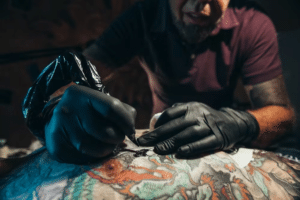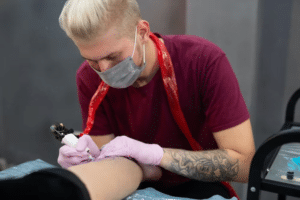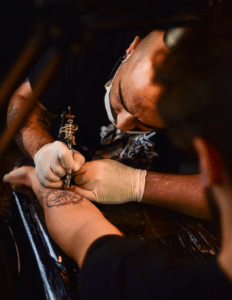From Concept To Skin: Crafting The Perfect Tattoo Design
Are you considering getting a tattoo but don’t know where to start? Designing a tattoo requires careful consideration to ensure the design is meaningful and beautiful and will stand the test of time.
This article will explore different ways of designing a meaningful and creative tattoo for yourself. We’ll discuss how to come up with ideas for a tattoo, how to choose an artist and what safety precautions should be taken when getting a tattoo.
Choose The Location Of Your Tattoo
Choosing where to place a tattoo is one of the most important decisions in a tattoo design. It can make or break the appeal of the artwork, and it’s crucial to consider all aspects before settling on a spot.
First, it’s essential to think about your lifestyle and how visible you want your tattoo to be. If you need to keep your ink under wraps for work purposes, opting for areas such as the upper shoulder or back may be more appropriate.
Another factor to consider when choosing where to place a tattoo is how much pain you will endure. Certain areas on the body are more sensitive than others, such as ribs, ankles, and wrists – so if you have a low pain threshold, it might be wise to choose a less painful area.
Look For Design Inspirations
When it comes to designing a tattoo, finding inspiration is key. There are many different sources of inspiration that you can turn to when brainstorming your next design. Whether you’re a seasoned tattoo artist or just starting, the right inspiration can help take your work to the next level.
One great source of inspiration for tattoo designs is nature. From animals and plants to landscapes and seascapes, no shortage of natural beauty can inspire your work. Consider looking at cultural symbols and iconography for ideas that resonate with you.
Another way to find inspiration for designing tattoos is by exploring art forms like painting, sculpture, and graphic design. These mediums offer unique perspectives on colour, composition, texture, and other elements that can inform your work as a tattoo artist.
Start Sketching
If you’re looking to get a tattoo, designing it yourself can be a great way to ensure that you end up with something unique and meaningful. However, if you don’t have any experience with drawing or design, the idea of creating your tattoo might seem daunting. That being said, the truth is that anyone can learn to sketch out their ideas and turn them into beautiful tattoos.
The first step in designing your tattoo is to start sketching. Even if you don’t feel confident in your artistic abilities, putting pencil to paper and practising different shapes and designs will help you develop your skills. Don’t worry about making everything perfect immediately– sketching is to explore different ideas and see what resonates with you.
When sketching for tattoos specifically, there are a few things you’ll want to keep in mind.
Choose The Right Palette
One of the most important decisions you’ll make when designing a tattoo is choosing the right colours. Tattoos are a form of self-expression; your chosen colours can greatly impact your design’s overall look and feel. Whether you’re getting your first tattoo or adding to an existing collection, understanding colour theory can help you make more informed choices.
One thing to consider when choosing tattoo colours is skin tone. Certain colours may look more vibrant on lighter skin tones, while others may be more muted on darker skin tones. Additionally, some ink colours may not appear well on certain skin types. If you’re unsure which colours work best for your skin tone, consult your tattoo artist or research online.
Another factor to keep in mind when selecting tattoo colours is longevity. Over time, tattoos can fade and lose their vibrancy due to sun exposure and natural ageing.
Design Techniques To Consider:
Designing a tattoo can seem daunting, but with the right approach and techniques, it can be a rewarding experience. There are several factors to consider when designing a tattoo that not only makes it visually appealing but also ensure that it will stand the test of time.
Here are some design techniques to remember when creating your next tattoo.
Handmade Tattoo Designs
Hand-drawing your tattoo design can be a unique and personal way to make your body art stand out. This approach allows you to create an original piece tailored to your taste and preferences. When designing a tattoo by hand, you can experiment with different shapes, styles, and colours until you find the perfect combination that reflects your personality.
One of the advantages of hand-drawing your tattoo design is the ability to see how it looks on paper before committing it permanently to your skin. You can make any necessary adjustments until you feel completely satisfied with the outcome. Additionally, drawing by hand gives you complete control over every detail of the design, which means that no two tattoos will ever look exactly alike.
Digital Tattoo Design
Digital Tattoo Design is the latest trend in the world of tattooing. With the advent of technology, it has become easier than ever to design and create unique tattoos that reflect your personality and style. Whether you are looking for a simple or complex design, digital tattoo design has made it possible to bring your ideas to life.
Digital tattoo design software allows you to experiment with different styles, fonts, colours and designs before getting inked. This means you can try different options until you find the perfect one that suits your taste. It also allows you to collaborate with your artist and come up with a design that is truly unique and custom-made just for you.
One of the biggest advantages of digital tattoo designing is that it enables artists to create more intricate designs.
Tattoo Apps To Help You
Luckily, technology has come to the rescue with various apps for tattoo design. These applications are designed to help people create personalised tattoos or find inspiration for new designs.
One of the most popular apps is Ink Hunter, which allows users to upload an image of their body parts and virtually try on different tattoo designs. Another great app is Tattoos Maker, which offers many tattoo designs in different categories, such as animals, tribal art, and symbols. This app also provides information about different types of tattoos and their meanings.
Another fantastic option is the Tattoodo app. This application features over 500k high-quality tattoo photos from some of the world’s best artists.
Conclusion
In conclusion, designing a tattoo involves research and thoughtfulness. It is important to consider your tattoo’s design, location, size, and colour to create a meaningful and impactful piece.
Consult with an experienced artist to ensure you make the right decisions for your body art. The process of designing a tattoo can be daunting but also rewarding if done correctly. With these steps, you can have the perfect tattoo that reflects your values and interests.
FAQs
What kinds of fonts and typefaces should be used for designs?
The fonts and typefaces used for any design should be chosen carefully. They can create a specific mood, style, and atmosphere to convey the design’s message.
When selecting fonts and typefaces, it is important to consider the context and audience of the design. For example, a modern sans-serif font might work well for targeting young adults, while an elegant serif font would be more appropriate for an upscale playful tattoo. Choosing fonts that are legible and appropriate for the target audience is key.
What are the most popular trending tattoos right now?
Right now, the most popular trending tattoos are minimalist designs. This includes small and simple designs such as geometric shapes, dainty florals, and delicate line work. These tattoos are often in black ink but can also include subtle pops of colour.
Another popular style is lettering tattoos. These can range from a single word or phrase to a longer quote or saying. Lettering tattoos are often done in script font and can be placed anywhere on the body.
Finally, watercolour tattoos have become increasingly popular recently. This tattoo style uses bright colours to create an abstract design that looks like a painting on the skin. Watercolour tattoos are larger than minimalist designs and lettering tattoos and require more time.
How much does the design process cost?
The cost of the design process varies depending on the project’s scope and the resources required. Generally, a basic design process can range from a few to several hundred pounds. More complex projects may require additional resources, such as specialised software or external consultants, which can significantly increase costs.




